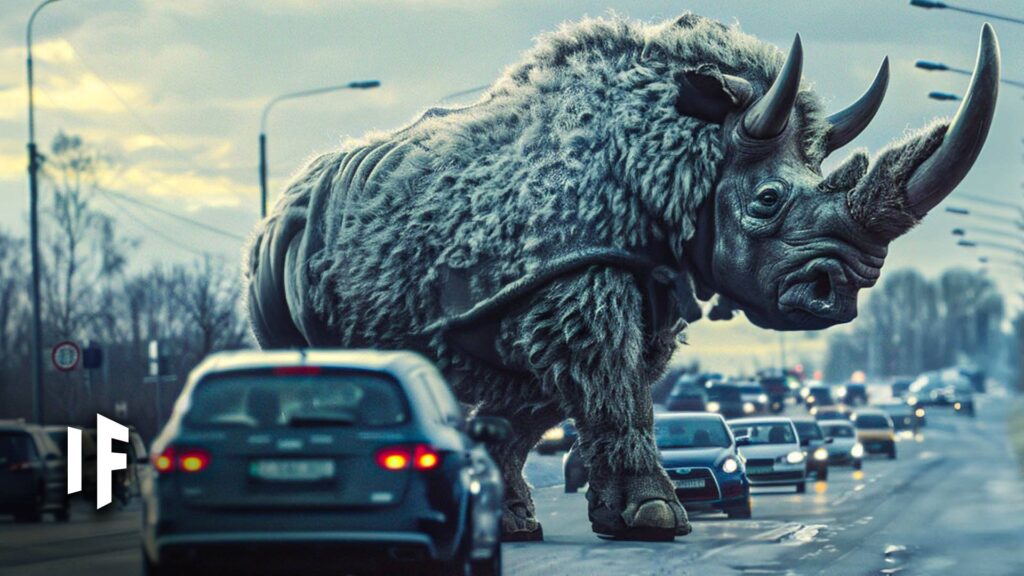The Woolly Rhino: A Lost Giant with a Lasting Impact
Imagine driving through a fast-food restaurant and seeing Woolly Rhino burgers on the menu. It might sound unusual today, but thousands of years ago, this massive Ice Age creature was a vital part of life for early humans. From food to tools, the Woolly Rhino played a central role in the survival and development of ancient societies. However, this magnificent animal vanished around 14,000 years ago. What if it had never gone extinct? How would the world look today if the Woolly Rhino still roamed the Earth?
The Woolly Rhino was a formidable creature, standing over six feet tall at the shoulder and weighing up to 2,000 pounds. Its thick fur coat and hump-like structure made it well-suited for the cold environments of the Ice Age. These animals were found across Europe and parts of Asia, thriving in open grasslands known as the “Steppe.”
If the Woolly Rhino had survived, its presence would have significantly influenced ecosystems, human cultures, and even modern technology.
Ecological Impact
One of the most immediate effects would be on the environment. The Woolly Rhino was a large herbivore that grazed on grasses and shrubs, playing a crucial role in shaping the landscape. Without it, the balance of these ecosystems may have shifted, leading to changes in plant diversity and other animal populations.
In addition, the Woolly Rhino’s grazing habits could have helped maintain open grasslands, preventing the spread of forests and preserving habitats for other species. This could have led to a different distribution of wildlife, potentially altering migration patterns and biodiversity.
Human Interaction and Culture
For early humans, the Woolly Rhino was more than just a source of food. Its hide provided warmth, its bones were used for tools and shelters, and its meat offered sustenance during harsh winters. If the Woolly Rhino still existed, it would likely have continued to play a significant role in human survival and culture.
The presence of such a large animal could have influenced the development of hunting techniques, social structures, and even spiritual beliefs. Many ancient cultures revered large animals, and the Woolly Rhino might have become a symbol of strength and resilience.
Technological and Economic Influence
The Woolly Rhino’s resources could have also impacted technological advancements. Its strong bones and durable hides might have been used in the creation of more sophisticated tools and clothing, potentially accelerating the development of early technologies.
Economically, the Woolly Rhino could have become a valuable resource, leading to trade networks centered around its products. This could have created new industries and economic systems based on the sustainable use of this ancient animal.
Environmental Changes
With the Woolly Rhino still present, the climate and geography of certain regions might have evolved differently. The animal’s grazing could have influenced the carbon cycle, affecting atmospheric CO2 levels and potentially altering global temperatures.
Moreover, the Woolly Rhino’s presence could have affected the spread of diseases and parasites, as its interactions with other species would have shaped the ecosystem in unique ways.
Cultural Legacy
Even in modern times, the Woolly Rhino could have left a lasting cultural legacy. Its image might appear in art, literature, and mythology, much like other iconic animals such as the mammoth or the saber-toothed cat.
Educational institutions could have incorporated the Woolly Rhino into their curricula, teaching students about its role in history and ecology. Museums and zoos might have dedicated exhibits to showcase this fascinating creature, helping to preserve its memory for future generations.
Conclusion
The Woolly Rhino was not just an animal; it was a keystone species that shaped the world in countless ways. Its extinction marked the end of an era, but what if it had never disappeared? The world today would be vastly different, with ecological, cultural, and technological impacts that we can only begin to imagine. By understanding the past, we gain insight into the possibilities of the future.







